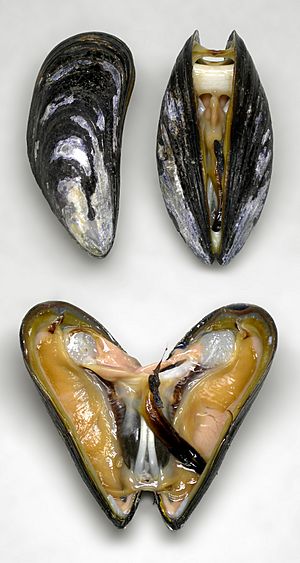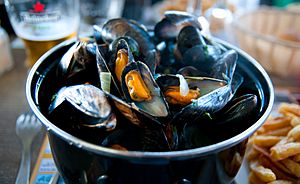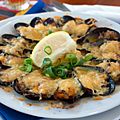Blue mussel facts for kids
Quick facts for kids Blue mussel |
|
|---|---|
 |
|
| Scientific classification | |
| Genus: |
Mytilus
|
| Species: |
edulis
|
The blue mussel (Mytilus edulis), also known as the common mussel, is a medium-sized marine animal. It's a type of bivalve mollusc, which means it has two shells hinged together. Blue mussels are part of the Mytilidae family, which includes all mussels. People often farm blue mussels for food, and you can find their empty shells on beaches all over the world.
Contents
Types of Blue Mussels
The Mytilus edulis Family
The blue mussel isn't just one type of mussel! It's actually a group of at least three very similar mussels. Scientists call this group the Mytilus edulis complex. These mussels live in the cool and cold waters of the North Atlantic and North Pacific oceans. You can also find them in the Mediterranean Sea and in similar areas in the Southern Hemisphere.
Sometimes, different types of mussels from this group can mix and have babies together if they live in the same place. People have also moved these mussels around the world, changing where they naturally live.
Here are some of the mussels in this group:
- Mytilus edulis (the main one): This mussel is originally from the North Atlantic Ocean.
- Mytilus galloprovincialis, the Mediterranean mussel: This one is from the Mediterranean Sea and Black Sea. It has also been introduced to other parts of the world.
- Mytilus planulatus, the New Zealand blue mussel: This type lives in the Southern Hemisphere, near Australia, Tasmania, and New Zealand.
- Mytilus platensis, the Chilean mussel: You can find this mussel in the cooler waters of South America.
- Mytilus trossulus: This mussel lives in the North Pacific, the northern Atlantic Ocean, and the Baltic Sea.
Where the Atlantic Blue Mussel Lives
The Atlantic blue mussel (M. edulis in its strict sense) is originally from the Atlantic coast of North America. It lives alongside M. trossulus north of Maine. In Europe, it's found from the French Atlantic coast all the way north to Iceland. It doesn't live in the Baltic Sea. In places like France and the British Isles, it sometimes mixes with M. galloprovincialis and M. trossulus.
Habitat
Blue mussels are animals that live in cool to temperate waters. They make their homes in intertidal areas. These are the parts of the coast that are covered by water at high tide and exposed to air at low tide. Mussels attach themselves to rocks and other hard surfaces. They do this using strong, stretchy threads called byssal threads. These threads are made by special glands in the mussel's foot.
Description
The blue mussel has a shell that looks like a triangle, but with rounded edges. Its shell is smooth and has fine lines that show how it grew over time. It doesn't have any bumpy ribs. The shells are usually purple, blue, or sometimes brown. They might even have stripes!
The outside of the shell has a thin layer called the periostracum. As this layer wears away, you can see the colorful part of the shell underneath. Blue mussels can move a little bit. They can detach their byssal threads and reattach somewhere else. This lets them move to a better spot in the water.
Reproduction and Life Cycle
Mussels have separate sexes, meaning there are male and female mussels. When they are ready to reproduce, male mussels release sperm and female mussels release eggs into the water. This is where fertilization happens. Even though a lot of sperm are released, not all eggs get fertilized. Also, only a small number of baby mussels (larvae) survive to become adults. Most of them are eaten by other animals before they can grow up.
Adult mussels need to be healthy to reproduce well. If they are stressed, for example, by high water temperatures or not enough food, they might stop making eggs and sperm. This can also make the baby mussels less healthy and less likely to survive.
Living Together: Aggregations and Mussel Beds
Blue mussels often live in groups, attaching to each other with their byssal threads. These threads are made of a strong protein. How they group together depends on how many mussels are in one area. If there aren't many mussels, they might form small clumps. They tend to group together more if there are predators nearby.
Scientists think mussels group together for a few reasons. It might help them have more babies when there aren't many mussels around. It could also help them stay safe from strong waves or protect them from predators. It's likely that grouping together helps them in different ways depending on the situation.
When mussels stay in one place long enough and grow very dense, they form "mussel beds." These beds are very crowded. Mussels in the middle of a crowded bed might not grow as big because there's less food for everyone. So, if they can, mussels will move to less crowded areas. However, they still like to clump together in small groups. Mussel beds are very important for the environment.
Predators
Blue mussels face the most danger when they are tiny larvae floating in the water. During this time, many animals, from jellyfish to adult fish, can eat them. Even after they grow into mussels with shells, they are still at risk. Smaller mussels with thinner shells are easier targets.
Once their shells get stronger, blue mussels are eaten by animals like sea stars and different kinds of sea gulls. Mussels have a clever defense: they can make their shells thicker! If a predator is nearby, a mussel can increase its shell thickness by 5 to 10 percent. This makes it much harder and takes longer for predators to open their shells. Small mussels are also eaten by a type of sea snail called the dog whelk.
Blue mussels can fight off one type of predator at a time. For example, they can strengthen their shell-closing muscle or grow thicker shells if a sea star or crab is around. But if they face two different predators at the same time, it's harder for them to defend themselves, and they can be eaten more easily.
Uses and Importance

Blue mussels are "filter feeders." This means they clean the water by filtering out tiny bits of food, bacteria, and even toxins. They play a very important role in coastal areas like estuaries by keeping the water clean.
People all over the world eat Mytilus edulis. They are harvested from the wild and also raised on farms. Mussels are a popular food in many countries, including Spain, Portugal, France, and Italy. They are also used in scientific studies. Native American peoples also harvested blue mussels for food.
Unfortunately, blue mussels are decreasing in some areas, like the Gulf of Maine. They have dropped by about 40 percent in the last 50 years. This is a problem because mussels are "foundation species." This means they provide homes and protection for other small animals, like tiny fish, in the intertidal zone. Without mussels, the water would also become much dirtier because they wouldn't be there to filter out bacteria, metals, and toxins. Also, changes in the ocean, like Ocean acidification, can make it harder for blue mussels to grow and survive. This could further reduce their helpful impact on water quality.
Gallery
Images for kids
See also
 In Spanish: Mejillón para niños
In Spanish: Mejillón para niños









